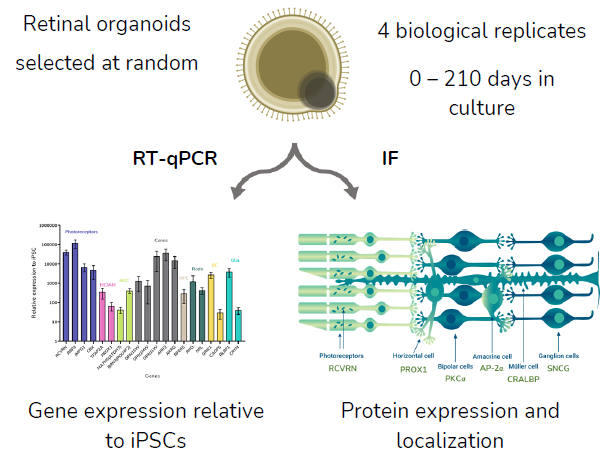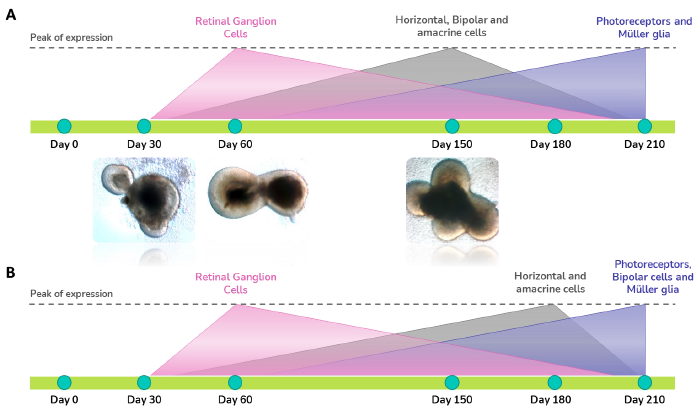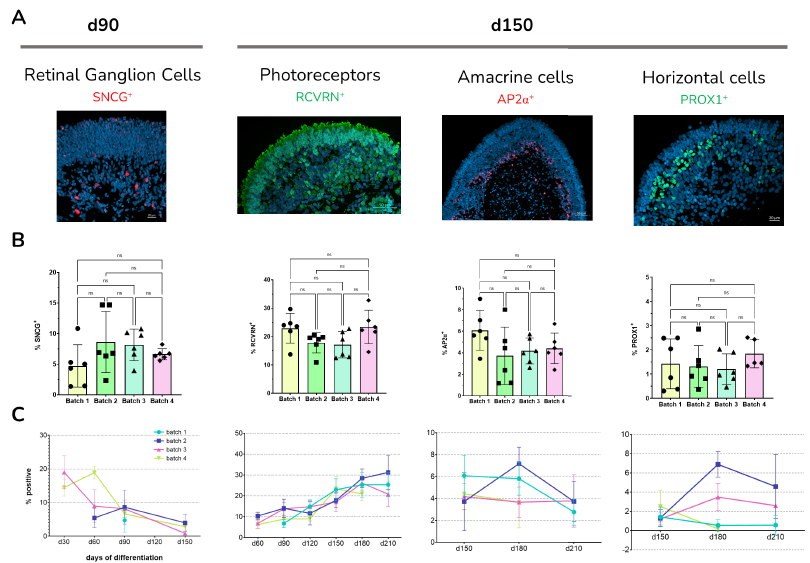This article is based on a poster originally authored by Carolina Gá ndara, Will Atkin, Hannah Steward, Madalaine Kay, George Buchanan, Lyle Armstrong, and Valeria Chichagova.
Purpose
Due to the well-documented limitations of in vivo and existing in vitro retinal models, there is a pressing need for a reproducible 3D in vitro model of the human retina that can accurately predict in vivo outcomes.
The study's objective was to investigate the consistency of human iPSC-derived retinal organoids (ROs) produced at scale by quantifying the gene and protein expression levels of key retinal cell markers throughout differentiation across multiple batches.
Methods

Image Credit: Newcells Biotech
Results

Figure 1. Photoreceptor (PR; Genes: RCVRN, RBP3, IMPG1, CRX; Protein: RCVRN), bipolar (BC; Genes: GRIK1, CADPS; Protein: PKCα), Müller glia (MG; Genes: RLBP1, CRYM; Protein: CRALBP), retinal ganglion cell (RGC; Genes: MATH5, BRN3; Protein: SNCG), horizontal and amacrine (HC/AC; Genes: PROX1, TFA2A; Protein: PROX1, AP2α), Cone PR (Genes: OPN1SW, OPN1MW, OPN1LW, ARR3, RXRG; Protein: OPN1MW/LW) and Rod PR (Gene: RHO, NRL; Protein: RHO) cell markers are expressed at different times throughout RO development which resembles in vivo development. (A) Gene expression and (B) protein expression of RGC markers peak between day 30-90, when PR progenitor cells start differentiating. Expression of cone and rod PRs initiate from day 120 and achieve highest expression and maturation levels after 210 days in culture. Image Credit: Newcells Biotech

Figure 2. (A) Distribution and localization of key retinal cells in RO at day 90 and 150 of differentiation. (B) Quantification of cell populations revealed that at day 150 of development, PRs, AC, RGC and HC represent on average 20%, 4.6%, 3% and 1.6% of the total number of cells This average was consistent across 4 biological replicates ( P>0.05 error bars = SD) for PR, AC and HC at d 150 and RGC at d 90 (mean 7%). (C) RGCs are more abundant in early developmental stages, whereas the appearance of PRs gradually increases throughout RO development and plateaus at day 210 with nearly 30% RCVRN+ cells. Image Credit: Newcells Biotech
Conclusions
This study analyzed the gene and protein expression profiles of key retinal cell markers during differentiation in four batches of human iPSC-derived ROs.
The findings indicate that photoreceptors (PRs), horizontal cells (HCs) and amacrine cells (ACs) exhibit consistent levels at later stages of development, while retinal ganglion cells (RGCs) display stable expression at early stages.
This data set provides essential information for pre-clinical studies involving ROs, with potential applications in drug discovery, disease modeling, and gene therapy.
Acknowledgments
Produced from material originally authored by Carolina Gándara, Will Atkin, Hannah Steward, Madalaine Kay, George Buchanan and Valeria Chichagova from Newcells Biotech and Lyle Armstrong from Newcastle University.
About Newcells Biotech
Newcells Biotech develops in vitro cell-based assays for drug and chemical discovery and development.
Using our expertise in induced pluripotent stem cells (iPSCs), cellular physiology, and organoid technology, we build models that incorporate the “best biology” for predicting in vivo behavior of new drugs.
Our experts have developed and launched assays to measure transporter function, safety, and efficacy in a range of cell and tissue types, including kidney, retina and lungs.
We have the capability to develop and implement protocols to measure cilia beat frequency and toxicity on small airway epithelial cells model, retinal toxicity and disease modelling on retinal organoids and retina epithelium, as well as drug transport in the kidney, DDI and nephrotoxicity across human and a range of preclinical species.
Sponsored Content Policy: News-Medical.net publishes articles and related content that may be derived from sources where we have existing commercial relationships, provided such content adds value to the core editorial ethos of News-Medical.Net which is to educate and inform site visitors interested in medical research, science, medical devices and treatments.
Last Updated: May 13, 2025